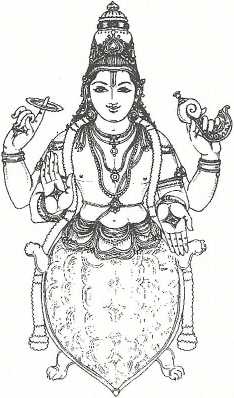By Swami Harshananda
Kurma literally means ‘the tortoise’.
The devas (gods) and the dānavas (demons) started churning the kṣīrasamudra, the ocean of milk, for obtaining amṛta or ambrosia on the suggestion of Mahāviṣṇu. The mount Meru was the churning rod and Vāsuki, the serpent king was the rope. During the process of churning, the mount Meru started sinking. Hence at the request of the two parties, Mahāviṣṇu took the form of a huge kurma or tortoise and supported the Meru mountain on his back. This is considered as the Kurmāvatāra or Kurma incarnation of Mahāviṣṇu.
Iconographically, he is shown either as a tortoise or with the lower part as a tortoise and the upper part in the human form. The human form exhibit four hands. These hands display having:
- Two hands carrying the emblems of Viṣṇu - śañkha or conch and cakra or the discus
- Two hand showing the poses of abhaya (protection from fear) and varada (giving of boons
- Sometimes the gadā (mace) is shown in the right hand instead of the discus
Kurma, an upaprāṇas[edit]
Kurma is also the name of one of the five upaprāṇas[1] responsible for opening the eyelids.
Kurma, a Mudrā[edit]
Kurma is also the name of a handpose used in pujā or worship.
References[edit]
- ↑ Upaprāṇas means minor vital-airs.
- The Concise Encyclopedia of Hinduism, Swami Harshananda, Ram Krishna Math, Bangalore

